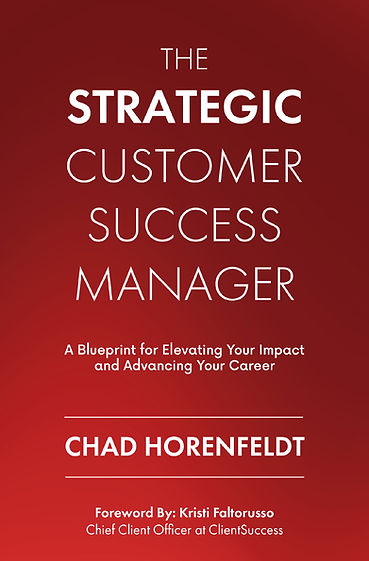“I Want Your Job”: Why CS Leadership Isn’t What You Think—and What It Takes to Get There
- Chad Horenfeldt
- Jul 26
- 3 min read
Let’s be honest—if you’ve ever led a customer success team, you’ve probably heard this one before:
“I want your job.”
I’ve heard it from candidates. I’ve probably said it (a little more humbly) when I was starting out. There’s ambition there, and I respect that. But here’s the part that doesn’t get talked about enough:
CS leadership isn’t as glamorous as it looks.
Yes, I love what I do. I’ve built CS teams at companies like Oracle (Eloqua), Influitive Bluecore, Meta (Kustomer) and more. I’ve had the chance to shape how we deliver customer outcomes at scale. But the work is demanding. The margin for error is thin. And the stakes are high—not just for customers, but for your team, your company, and your own career.

Startups Don’t Scale Themselves—People Do
At Influitive, I helped scale the CS organization from 4 to nearly 30 people while our customer base grew 10 times in two years. The lessons I learned during that time weren’t just tactical—they became part of my DNA. And they’re now embedded in The Cycle of Customer Success—specifically the People component, which I believe is the most critical element of the model.
Here’s why: everything flows from people—your hiring practices, your team structure, your onboarding, your culture, your capacity to deliver. Get it wrong, and the best tech stack and cleanest journey map won’t save you.
Hiring Is Strategy, Not Admin
One of the hardest-earned lessons of my career is this: don’t mess around with hiring.
You need to plan ahead, hire fast (when it’s time), and hire smart—especially when you’re scaling in a high-growth environment.
I’ll never forget a moment at Influitive when a team member said to me during a team huddle:
“Chad, we’ve built something special here. Don’t mess it up.”
It hit me. And it kept me up at night.
We had a lull in deals followed by a massive sales spike. Suddenly, we didn’t have enough resources to adequately manage our client load, and I had to jump in myself. If you’re a CS leader managing direct customers and your ARR is greater than $5 million, something isn't right. That isn't where you should be spending your time. But with recruiting delays and no backup plan, the team was overwhelmed. Execution suffered. Churn crept in.
Instead of celebrating a revenue high, we were hyperventilating.
How I’d Do It Differently (and What You Can Learn)
Looking back, here’s what I would have done differently:
Track the sales pipeline like your job depends on it—because it does. This will help you determine how to align your resources and if you need to hire.
Partner early with your sales counterpart. Forecast alignment isn’t optional. You need to be tied with the sales leader at the hip.
NSR: Never. Stop. Recruiting. Your internal and external recruiters are great, but you need multiple sourcing paths. The CS leader or hiring manager must take a strong role in the recruiting efforts - especially at an early-stage start-up.
Leverage technology to scale your team. I used to recommend that you hire ahead of time but now I would recommend streamlining your processes and leveraging AI before you turn to hiring.
I’m constantly building a candidate pipeline—whether it's meeting with potential candidates in the NYC area or through my content creation. You can’t lead a team effectively if you’re always scrambling to fill seats.
If You Want My Job, Read This First
To the folks I interview who tell me they want my job: I love that. Truly. There’s no greater honor for a leader than seeing someone on their team rise.
But know this:
This job is hard.
It’s high-stakes.
And it requires constant learning, humility, and planning.
That’s why I created The Cycle of Customer Success. It’s not just a model—it’s a practical guide built on real lessons from the frontlines. And if there’s one part of it that defines whether you scale well or stall out, it’s the People.
Because CS isn’t just about your customers. It’s about building the team that will fight for them.
Stay tuned for my next post—I'll tackle another leadership Achilles’ heel: communication.







Comments